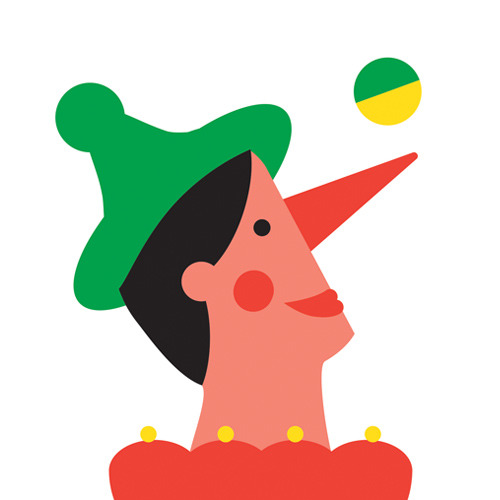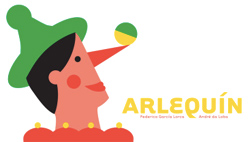< Back to posts
André da Loba
Portugal

André da Loba is a Portuguese illustrator, animator, graphic designer and sculptor, whose work has achieved international acclaim and won him numerous awards. He's worked with a wide range of clients such as The New York Times, The Washington Post, Time Magazine, Bruaá, Companhia das Letras and Orfeu Negro. André lives in Brooklyn.
In this post, André talks about the creation of ‘Arlequín’, an ambitious project he collaborated on with children's literature specialists, ‘Tres Brujas’. This unique book-object, which is based on a short poem by Federico García Lorca, is published by Barbara Fiore Editora.
André: This project happened after a series of happy coincidences. In 2012, I was giving a performance at the Bologna Children's Book Fair when the ‘Tres Brujas’ (Three Witches) were passing by and decided to stay, introduce themselves, and become my instant friends. As they say, ‘birds of a feather flock together’.
The ‘Tres Brujas’ are a team of children's literature specialists that run a children's bookshop in Gijón, Spain, called the Líbreria El Bosque de la Maga Colibrí.
As is the tradition in Bologna, illustrators, publishers and writers tend to join each other in animated dinners from where, once in a while, synergies happen and audacious projects sprout. During one of those dinners, and over great Italian food and wine and many laughs, we decided that we wanted to make a book together. Although this might seem like a very general idea, we knew it had to be for babies and had to be used as a performance piece or manipulated object – not just a book but also a voyage. Basically, an impossible book.
A year passed and we met again, randomly, during the next Bologna fair. They had found this pearl by Lorca from a collection of poetry from 1921–1927. It goes like this:
Arlequín
Teta roja del sol / Red breast of the sun
Teta azul de la luna / Blue breast of the moon
Torso mitad coral / Torso half coral,
mitad plata y penumbra / half silver and penumbra
Now that I look at it, I think it's funny that as we conceived this project in Bologna, we ended up choosing the Arlecchino, a character that is so iconic of the Italian Commedia dell'Arte. It all fits together in a kind of serendipitous way: the performer, the comedian and the mischievous servant. It has a very tactile personality. Also, to get the chance to make an homage to Lorca, one of everyone's favourite poets, was an honour.
When I got back to my studio, I started to work on it right away. As simple as it might seem, this poem has a lot of baggage. It speaks about night and day, life and death, love... To explain all this to newborns became a more cumbersome task than I ever imagined. It took us two years and a dozen versions to feel like we accomplished it.
Our process went from regular leporello, which seemed too linear, to a sculptured version of the character himself, to this final version that has a bit of both. There was a lot of back and forth. We had to get Lorca's universe well represented and at the same time keep it simple and eloquent.
At the beginning, we were trying to relate directly to the text: using boats, celestial bodies and basic shapes to tie it all together. Something was missing; it all seemed too random. Until one day, someone suggested we should combine two previous versions we'd made, and then the little fish showed up. From there it was an easy step to make the fish fall in love with the moon and become a bird, as Lorca himself would have done.
That was when it all became easier. We had a story to tell and it was a good one. One that went through the stages of love: from infatuation, to enchantment, to deep love.
Now all we had to do was to test it. As our target audience was babies, it was hard to get a conclusive response. So every time I adjusted a version, the ‘Tres Brujas’ would take the dummy to the kids during one of their story-time workshops and watch their reactions: what their eyes would follow, what gestures they would imitate, what colour combinations they reacted to, what sequence mesmerised them. From those observations, we would make more adjustments.
Although tiring and sometimes frustrating, this was a very interesting and reassuring process. We knew that we were getting to a final form that would be sensitive to the babies' way of absorbing their surroundings.
During the final stages, the book got picked up by the amazing Barbara Fiore, who hopped on board with us to create this special edition, taking special care over the materials and how to communicate it.
The final result is a book-object that I'm very proud of because if combines poetry, visual arts and performance in a form which is suitable for little ones enjoying their first poem, and also for long-time readers.
Illustrations © André da Loba.
Arlequín
Federico García Lorca & André da Loba
Barbara Fiore Editora, Spain, 2015
A four-line poem by Federico García Lorca shapes the universe in this unique book-object conceived by André da Loba and the ‘Tres Brujas’ team. A journey from day to night, through the body, through love and death.













